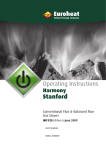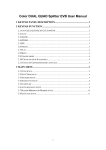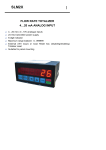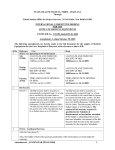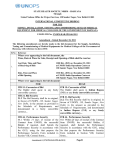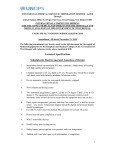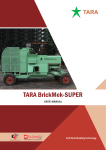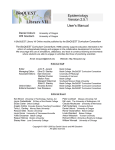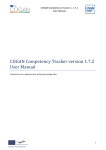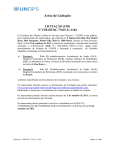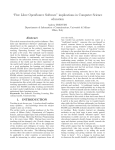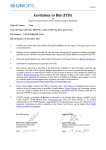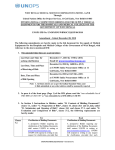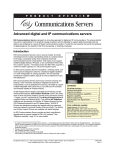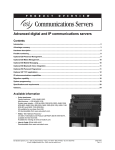Download Post Ebola Recovery Program in Sierra Leone Anx. B.2
Transcript
SECTION V Anx. B.2 – SCOPE of WORKS & Anx B.3 TECHNICAL SPECIFICATIONS Post Ebola Recovery Program in Sierra Leone REF: RFQ/2015/B5317/96718/GD/010 Request for Quotation (RFQ) For PHOTO VOLTAIC SYSTEMS TO POWER LIFT PUMPS Anx. B.2 Scope of Works & Anx. B.3 – Technical Specification November 2015 Project Partners: Ministry of Health and Sanitation (MoHS) Funding source: Department for International Development (DFID) SECTION V Anx. B.2 – SCOPE of WORKS & Anx B.3 TECHNICAL SPECIFICATIONS Table of content 1. Background 2. Project definition – minimum requirements a) System minimum requirements b) Material characteristics and standards c) Installation requirements 3. Project outputs a) Testing plan b) Set in function procedures c) Training for user and maintainer main contents 4. Suggested timing schedule Annexes : B.2.1 location details (with quantity) SECTION V Anx. B.2 – SCOPE of WORKS & Anx B.3 TECHNICAL SPECIFICATIONS 1. Background Scope of this document is to describe the general and detailed Technical requirements for the supply of PV solar system for powering of lift pumps of Sierra Leone government hospitals (included in the Post Ebola recovery Program). This to define as better is possible the environmental and technical conditions in order to facilitate the understanding of the Bidders and giving them the base parameter on which to estimate the cost and eventually to build the project. The document defines and explains technical specification for the PV system as well as example of proposed solutions. These solutions are minimum requirements and if/even the Bidder choses to modify or change any of these requirements he is supposed to justify and prove that the system will anyway comply with the above mentioned requirements. The system has to be intended the lowest maintenance impact is possible with compact inverters. All details are explained in below paragraphs (the system description) with the limits and the data of the actual situation for the structures and the indications for the technical solution. 2. Project Definition - minimum Requirements This paragraph is devoted to the definition, including installation and start-up, of a Solar Panel System for lift water pumps in Sierra Leone Hospitals under UNOPS project management and Works Supervision. A. Material Characteristics and Standard The system Minimum characteristics shall be as described in the below paragraphs I. characteristics - The system shall have the dimensions of 5 kwp/h - System shall be organised in panels of 250w/300w installed on a roof - Panels shall be at least 250W poly crystalline construction - Panels shall be mounted on anticorrosion metal frames - Metal frames shall be fixed on the roof with a waterproof hard connection - System shall have a self-standing Inverter auto protected - Inverter shall be in a self container unit including regulator and battery - Panels shall be connected in streams - The system shall provide battery charge feeding - The system shall be able to be connected with generator if available for emergency use. - A control panel shall be supplied for main switches controls and water levels control switches of the system. SECTION V Anx. B.2 – SCOPE of WORKS & Anx B.3 TECHNICAL SPECIFICATIONS II. Location The system shall be located on the roof of the selected building with the control located in a close place near the Lift pumps shelter area Anyway it shall be in a safe (lockable box) not humid place III. Connection The purpose of the system is to feel the elevated tank of the hospitals moving the water from ground tanks .For this purpose we shall optimise the pump functioning to not stress them. System shall automatically start when the level of the elevated tank decrease and stop when the tank is filled again Take into account in many case there are multiple elevated tanks Manual override switches shall also be provided in the control panel Tank level automatic switch and relevant control/override on the panel shall be supplied IV. Components a. Solar panels - The total power shall be obtained by streams of PV panels - Panels shall be poly crystalline type. - Panels shall be Aluminium framed with hard glass face covers. - The panel selection shall be made from state of the art of the PV technology with best efficiency to be declare. - PV Panel brands shall be declared with Data Sheet and certifications. - Stream voltage shall not be high voltage to avoid magnetic effect. - PV wiring and connections shall be waterproof - Solar panel shall come to the work field properly tested and certified - PV shall come to the work field properly package to avoid damaging. - PV shall be guarantee 20 years with 90% efficiency - PV shall be guarantee 10 years against any kind of production defect. - UNOPS reserve the right to make inspections on the site and verify the panels work with thermal and electrical systems. b. - Wiring of PV panels The PV panels shall be wired in streams The streams shall be built in a way to match the inverter voltage inputs Wiring shall be of 6mm diameter solar wire, certified and with dedicated junction connection; brand and characteristics shall be declared with Data sheet and certificate Streams shall go directly to the self standing power unit (battery/regulator/inverter). Stream dimensions and connection to the Inverters shall be shown in the project. SECTION V Anx. B.2 – SCOPE of WORKS & Anx B.3 TECHNICAL SPECIFICATIONS c. Inverter - Inverters connections shall be shown in the bid tech docs. - Inverter output shall be 380V three phasic; It shall be self-contained (one unit) for its all inverting power - Inverters shall be one box self-contained for easy maintenance and fulmination risk reduction - Inverters Unit shall have indicator of power production and main on/off switches - Inverter Unit shall be self-protected against short circuit, overheating, over voltages. - Inverter Unit shall have a display unit where are show the working data and recorded the production data as well as battery charge display. - Batteries shall be 50kw storage capability (5 hour minimum work for the system) - Inverters shall have a remote data control pre-disposition LAN card - All system efficiency shall be declared (and over 95%) - The efficiency of the inverters shall be declared - The data Sheet with brand shall be annex to the Bid - Inverter Unit estimated life shall be at least 20 years (or declared one) - Inverter Unit warranty time shall be at least 10 years (or declared one but battery warranty is a must) - Extra warranty will be considered in the evaluation V. Interfaces The interfaces of the PV solar system shall be with the self contained inverter/battery unit. If any combiner box is need it shall be declared B. Section 1.2 - Material characteristics and standards The material supplied shall be in conformity to the international standard of PV systems. The Standard shall comply with the quoted system are: 62446-1 Generic Specs for PV systems IEC 61730-1:2004 Ed. 1.0 and IEC 61730-2:2004 Ed. 1.0 Photovoltaic module safety qualification IEC 61215 & IEC 61646 IEC 61215:1993 Ed. 1.0 and IEC 61215:2005 Ed. 2.0 Crystalline silicon terrestrial photovoltaic (PV) modules - Design qualification and type approval IEC 61646:1996 Ed. 1.0 Thin-film terrestrial photovoltaic (PV) modules – Design qualification and type approval SECTION V Anx. B.2 – SCOPE of WORKS & Anx B.3 TECHNICAL SPECIFICATIONS IEC 60364-7-712 Electrical installations of buildings Part 7-712: Requirements for special installations or locations - Solar photovoltaic (PV) power supply systems. IEC 61727 Photovoltaic (PV) systems - Characteristics of the utility interface. IEC 61683 Photovoltaic systems - Power conditioners - Procedure for measuring efficiency. IEC 62903 Charge and controllers & MPTT IEC 61701 Salt mist and corrosive IEC 61427 Storage Batteries IEC 60189 Cables/switch/circuit Breaker and connections IEC 60028 Environmental C. Installation requirements I. General The Sierra Leone hospitals are located in raining season areas. This location and environmental conditions impose an installation who guarantee the resistance at corrosion and an high isolation at humidity effects. The bidder shall indicate clearly detailed solution for this purpose. We remember that the system shall show waterproofing capability in an high humidity and rain environment as well high sun radiation. II. Panels support structure - Panel support structure and fixing shall be corrosion proof material - Panels shall be placed in single or double raw with tie fixing to the structure as less is possible in order to preserve the waterproofing of the roof but sufficient to justify the storm resistance. - Waterproofing reinforcements are required in the area of fixing and contact between structure and roof - Bolt and metal fixing shall be electrically isolated from panel frame in order to avoid corrosion from inducted static electricity. - All Bidders proposed installation system will be considered and evaluated with their own calculations III. Panels positioning - Panel inclination shall be calculated from the position of Sierra Leone and the average position of the sun during daily hours along the year. The average efficiency along the year shall be calculated from bidder with the selected inclination and supplied in the Bid - Panels shall be solidly fixed at the frame by bolts (not by clips). - Bidder shall provide panels inclination and efficiency justification SECTION V Anx. B.2 – SCOPE of WORKS & Anx B.3 TECHNICAL SPECIFICATIONS 3. Section 2 – Project outputs Output of the project shall be : - A PV off grid solar system of total 5kwhp installed and working at Sierra Leone defined hospitals for Lift pumps powering. - An Inverter/battery system self contained able to work for at least 5 hours during no sun time. - The final test, the documentation and reports defined during the testing procedures signed for acceptance from both the supplier and UNOPS responsible - A trained person(s) capable to operate the system in its primarily interfaces. A. Testing plan The Testing and Documentation delivery by supplier of the system shall be based on IEC 62446 Minimum Requirements for System Documentation, Commissioning Tests and Inspection. System documentation is the evidence used to demonstrate that appropriate precautions and tests have been undertaken prior to handing over a PV system to the property owner. Testing shall be carried out by the contracted company with the UNOPS responsible witness (commissioning team) following the here below procedures. I. SYSTEM DOCUMENTATION System documentation requirements are laid out in Clause 4 of the norm, which describes the minimum documentation that should be provided for the benefit of the customer, inspector or maintenance technician following the installation of a grid-connected PV system. These requirements are organized into six categories: 1) 2) 3) 4) 5) 6) 7) system data wiring diagram data sheets mechanical design information O&M information Warranties and user manuals test results and commissioning data System data Minimum system data requirements outlined in IEC 62446 include basic nameplate information and details that you would expect to find on the cover page of a PV plan set or a system commissioning package. Nameplate data requirements include rated system power and the manufacturers, models and quantities of PV modules and inverters/battery unit . Cover page data requirements include contact information for the customer, system designer and system installer, plus relevant project dates. SECTION V Anx. B.2 – SCOPE of WORKS & Anx B.3 TECHNICAL SPECIFICATIONS Wiring diagram According to IEC 62446, system documentation for off grid connected PV system shall include at minimum a single-line wiring diagram. A list of subsections outlines the specific information that needs to be included in the notes or tables associated with the wiring diagram. Annotations to the single-line diagram must include general information about the quantity and type of modules, as well as specific details about the source-circuit and sub array makeup. IEC 62446 also requires information about the location and type of balance of system components. Details need to be provided regarding conductor sizes and overcurrent protection device ratings. In addition to equipment grounding details, in particular module frame grounding, any connection to an existing lightning protection system needs to be identified, as do the locations, types and ratings of ac or dc surge protection devices. IEC 62446 also details minimum information requirements regarding the existing ac electrical system. Datasheets Per IEC 62446, module and inverter/battery unit datasheets must be provided in the system documentation at a minimum requirement. An informational note clarifies: “The provision of datasheets for other significant system components should also be considered.” Mechanical design A datasheet for the array mounting system needs to be provided, at a minimum. Where is clearly identified the mounting system (compatible to requirements) and the relevant materials who will be used. Nevertheless it shall be shown the structure fixing on the roof with evidence to the waterproofing of the fixing point. O&M information Meeting the requirements found in subsection 4.6 of IEC 62446 (see sidebar) is inherently more subjective than other system documentation requirements. Proper documentation of system O&M information depends upon the audience and may involve a significant investment in time and resources on the project back end. Exaustive templates with information dedicated to hospitals project shall be supplied This is especially true when a facility’s maintenance personnel are expected to take on routine maintenance activities for the PV system. Warranties and user manual Documents of the warranties (efficiency and functioning) shall be provided as per SoW requirements. User manual who drive the Startup, commissioning and Periodic maintenance with all the information to allow to the maintenance people to maintain and repair minor failures. Test results and commissioning data IEC 62446 requires that copies of test results and commissioning data be included in the documentation package. At a minimum, this must include the results of the verification tests outlined in Clause 5 of the standard. System verification is achieved through inspection, followed by testing. These steps must be documented in a verification report. SECTION V Anx. B.2 – SCOPE of WORKS & Anx B.3 TECHNICAL SPECIFICATIONS II. INSPECTION The inspection to the system shall be carried out in separate steps against the requirements contained in the SoW Physical inspection The system shall be visually revised to verify it commit the data and the project delivered by the bidder during tender phase and confirmed in case of order PV module physical location, subsystem subdivision, Inverter location and main line connections. Fixing structure verification, frame module thickness and structure hardness. Quantities and visual aspect and Nameplates of the items will be checked with hevidence of report. Electrical verifications The requirements found in this subsection are intended to be completed “prior to energizing the system.” Inspection activities are broken into 2 subcategories: 1) DC system, overvoltage and shock, 2) AC system, and labeling and identification. Testing Testing of PV systems should be conducted in accordance with NFPA 70E, Electrical Safety in the Workplace, published by the National Fire Protection Association. To mitigate electrical hazards, workers must employ personal protective equipment commensurate with the electrical energy present, follow proper procedures and use appropriate tools. IEC 62446 requires that the AC circuits be tested first, then the following six DC circuit tests be performed, preferably in this order: 1) Test continuity of equipment grounding conductors and system grounding conductors (if applicable). 2) Test polarity of all DC cables and check for correct cable identification and connection. 3) Test open-circuit voltage [Voc] for each PV source circuit. 4) Test short-circuit current [Isc] for each PV source circuit. 5) Test functionality of major system components (switchgear, controls, inverters/batteries), including inverter anti-islanding. 6) Test the insulation resistance of the dc circuit conductors. All test shall be resumed in testing data sheet and annex to test documentation The methods for performing these tests are generally familiar to all electricians. However, difficulties may arise if the technician is unaware of the extent to which PV circuits need to be segmented and isolated for these tests to be performed properly. Therefore, it is important that anyone performing these tests be specifically qualified with regard to PV systems. Combinations of standard electrical test equipment can be used to complete the required tests, such as a mega ohm meter paired with either a digital multimeter or a clamp meter. Increasingly specialized test equipment is available for PV applications. While IEC 62446 does not specify the order of the tests, there is logic behind the order that it recommends. For example, if equipment is properly bonded to earth, then it is inherently safer SECTION V Anx. B.2 – SCOPE of WORKS & Anx B.3 TECHNICAL SPECIFICATIONS to work around in the event of a fault; and if polarity tests are not completed before functional tests are performed, then equipment may be damaged at start-up due to reverse polarity or overvoltage. Note that in the event that a test indicates a fault, the standard requires that all previous tests be repeated after the fault is rectified. This is because the fault may have influenced earlier test. Performance testing The system shall be tested as per performance declared by bidder during the tender and order phase. 1) Verify total power installed 2) Verify instantaneous power in full sunshade 3) Verify average power produced in one day/week 4) Verify battery and controller functionality (where need) 5) Verify Inverters connection /disconnection 6) Verify generators day night switch 7) Verify circuit and level breaking switches Testing documentation and reports All the documentation listed in Para 2.1.1 DOCUMENATION Para 2.1.2 INSPECTION Shall be delivered as acceptance documents to UNOPS and bound to the final payment Commissioning team The commissioning shall be carried out by a Commissioning team who is composed by N.1 Representative of the supplier N.1 UNOPS Commissioning Responsible The aim of the team is to better understand the realization of the project and to have supplier witness during test to avoid contestation and move fast to the system start up The Responsible of supplier has the role to explain and support the test of UNOPS responsible as has no judging role. UNOPS Responsible will carry out all the documentation checks and System testing as described in the above paragraphs and in behalf of international norms with evidence of problems or goodness of the system. All the Test will be supported by Reports where the UNOPS Responsible will define weather the system Has problems to be corrected or it is accepted as it is. The documentation listed in para 2.1.1 shall be all produced by the supplier and delivered to UNOPS responsible before the start of commissioning. The verification of the documentation will be the first part of commissioning If the documentation will pass the inspection successfully The inspection and test will be carry out on site Both the activities will be carried out by the commissioning team SECTION V Anx. B.2 – SCOPE of WORKS & Anx B.3 TECHNICAL SPECIFICATIONS B. Set in function procedures The Set in function procedures are a direct consequence of the Testing procedures. As soon the testing procedures are carried out the PV system is ready and capable to be connected at the load. The connection panels of each PV stream shall be controlled and connected to inverter/battery unit. The instruments of the subsystem panels shall indicate the tension/current are supplied to the pumps. The control Panel shall be tested in term or real breaking either for circuit or for level sensor breaking. The person in charge shall monitor the subsystem panels to verify that the PV are working. C. Training for user and maintainer main contents One or more person resident shall be trained to check the daily run and maintain of the system. Basically the system shall be fully automatic in its own start/stop operation and connection/reconnection activity. Anyway, a maintainer shall be trained in the daily checks and to troubleshoot possible minor problems. The maintainer shall have the System Manual where it shall be clearly described how to maintain the system in normal operation and a troubleshooting table to help solving minor failures. A training course shall be set as follows: N 1 days of general instruction on what are the solar system The training shall be structured with lesson inside and alternated to practical lesson where will be shown the detailed component of the system in order to give an overall picture of what is the solar system. The content of these 1 days shall be Theoretical arguments 1) General explanation of what is a solar system 2) Sun/power conversion principles 3) What is a solar panel 4) Sun/electricity mechanism 5) Inversion from DC to AC 6) Electricity distribution 7) Controls and meters 8) What are the parameters to be verified daily on subsystem display during system working and how to record them N 2 days of Theoretical instruction on how is the system and how they shall intervene on it Practical arguments 9) How is made a solar panel 10) How is connected each other with stream formation 11) How is fixed on the frame 12) How to maintain periodically the fixing system SECTION V Anx. B.2 – SCOPE of WORKS & Anx B.3 TECHNICAL SPECIFICATIONS 13) How to maintain the cleaning system 14) How to verify the wire lines 15) Action In case of Subsystem malfunctioning 16) Reset of a subsystem 17) What to never touch 18) Action to do in case the system do not restart 19) Useful Phone numbers A final examination shall be carried out at presence of UNOPS responsible. Hand out material shall be provided for the training as well as User and maintenance manual with all details to allow ordinary maintenance and minor failure troubleshooting 4. Section 3 – Suggested timing schedule Please refer to the Schedule in Annex Z for the detailed schedule of the RFQ process as well as a preliminary planning of the execution period (including Defect Liability Period).













